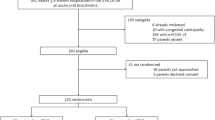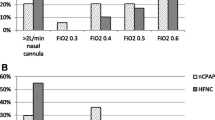Abstract
Bronchiolitis is a common respiratory illness in early childhood, often leading to hospitalization and associated healthcare costs. Low flow 100% oxygen through nasal prongs is the standard therapy for infants with bronchiolitis and hypoxemia. Nasal continuous positive airway pressure (nCPAP) or invasive ventilation is used in case of progressive respiratory failure. High flow heated and humidified oxygen therapy with delivery of an air-oxygen mixture up to 2 L/min/kg body weight via nasal prongs (referred to as high flow nasal cannula or HFNC) is a newer method for respiratory support. Initial data from retrospective studies were promising but should be interpreted with caution. A limited number of prospective randomized controlled trials (RCT) have now compared HFNC with either standard oxygen therapy (SOT) or nCPAP. In this review, we critically summarize the data from these RCTs with the aim to provide advice on how to position HFNC in clinical practice.
Conclusion: HFNC is a safe mode of respiratory support that can be positioned between SOT and nCPAP as rescue therapy for children not adequately supported by SOT. It does not seem to shorten the duration of oxygen need nor the duration of hospital admission.
What is Known: | |
• HFNC is being used increasingly in the context of infant bronchiolitis. However, evidence on efficacy and safety are limited. Different published studies involve different disease severities and different pediatric settings. | |
What is New: | |
• In this review, we summarize data only from prospective RCTs with the aim to provide guidance on how to use HFNC. |


Similar content being viewed by others
Abbreviations
- HFNC:
-
High-flow nasal cannula oxygen therapy
- LOS:
-
Length of stay
- nCPAP:
-
Nasal continuous positive airway pressure
- NIV:
-
Non-invasive ventilation
- PICU:
-
Pediatric intensive care unit
- RCT:
-
Randomized controlled trial
- SOT:
-
Standard oxygen therapy
References
Ralston SL, Lieberthal AS, Meissner HC, Alverson BK, Baley JE, Gadomski AM, Johnson DW, Light MJ, Maraqa NF, Mendonca EA, Phelan KJ, Zorc JJ, Stanko-Lopp D, Brown MA, Nathanson I, Rosenblum E, Sayles S III, Hernandez-Cancio S, American Academy of Pediatrics (2014) Clinical practice guideline: the diagnosis, management, and prevention of bronchiolitis. Pediatrics 134:e1474–e1502. https://doi.org/10.1542/peds.2014-2742
Slain KN, Shein SL, Rotta AT (2017) The use of high-flow nasal cannula in the pediatric emergency department. J Pediatr 93:36–45. https://doi.org/10.1016/j.jped.2017.06.006
Lee JH, Rehder KJ, Williford L, Cheifetz IM, Turner DA (2013) Use of high flow nasal cannula in critically ill infants, children, and adults: a critical review of the literature. Intensive Care Med 39:247–257. https://doi.org/10.1007/s00134-012-2743-5
Dysart K, Miller TL, Wolfson MR, Shaffer TH (2009) Research in high flow therapy: mechanisms of action. Respir Med 103:1400–1405. https://doi.org/10.1016/j.rmed.2009.04.007
Mikalsen IB, Davis P, Øymar K (2016) High flow nasal cannula in children: a literature review. Scand J Trauma Resusc Emerg Med 24:93. https://doi.org/10.1186/s13049-016-0278-4
Hutchings FA, Hilliard TN, Davis PJ (2015) Heated humidified high-flow nasal cannula therapy in children. Arch Dis Child 100:571–575. https://doi.org/10.1136/archdischild-2014-306590
Higgins JPT, Altman DG, Gøtzsche PC, Jüni P, Moher D, Oxman AD, Savovic J, Schulz KF, Weeks L, Sterne JA, Cochrane Bias Methods Group, Cochrane Statistical Methods Group (2011) The Cochrane Collaboration’s tool for assessing risk of bias in randomised trials. BMJ 343:d5928. https://doi.org/10.1136/bmj.d5928
Franklin D, Babl FE, Schlapbach LJ et al (2018) A randomized trial of high-flow oxygen therapy in infants with bronchiolitis. N Engl J Med 378:1121–1131. https://doi.org/10.1056/NEJMoa1714855
Kepreotes E, Whitehead B, Attia J et al (2017) High-flow warm humidified oxygen versus standard low-flow nasal cannula oxygen for moderate bronchiolitis (HFWHO RCT): an open, phase 4, randomised controlled trial. Lancet 389:930–939. https://doi.org/10.1016/S0140-6736(17)30061-2
Hilliard TN, Archer N, Laura H et al (2012) Pilot study of vapotherm oxygen delivery in moderately severe bronchiolitis. Arch Dis Child 97:182–183. https://doi.org/10.1136/archdischild-2011-301151
Ergul AB, Calıskan E, Samsa H, Gokcek I, Kaya A, Zararsiz GE, Torun YA (2018) Using a high-flow nasal cannula provides superior results to OxyMask delivery in moderate to severe bronchiolitis: a randomized controlled study. Eur J Pediatr 177:1299–1307. https://doi.org/10.1007/s00431-018-3191-1
Milési C, Essouri S, Pouyau R et al (2017) High flow nasal cannula (HFNC) versus nasal continuous positive airway pressure (nCPAP) for the initial respiratory management of acute viral bronchiolitis in young infants: a multicenter randomized controlled trial (TRAMONTANE study). Intensive Care Med 43:209–216. https://doi.org/10.1007/s00134-016-4617-8
Sarkar M, Sinha R, Roychowdhoury S et al (2018) Comparative study between noninvasive continuous positive airway pressure and hot humidified high-flow nasal cannulae as a mode of respiratory support in infants with acute bronchiolitis in pediatric intensive care unit of a tertiary care hospital. Indian J Crit Care Med 22:85–90. https://doi.org/10.4103/ijccm.IJCCM
Vahlkvist S, Jürgensen L, la Cour A et al (2019) High flow nasal cannula and continuous positive airway pressure therapy in treatment of viral bronchiolitis: a randomized clinical trial. Eur J Pediatr 179:513–518. https://doi.org/10.1007/s00431-019-03533-2
McKiernan C, Chua LC, Visintainer PF, Allen H (2010) High flow nasal cannulae therapy in infants with bronchiolitis. J Pediatr 156:634–638. https://doi.org/10.1016/j.jpeds.2009.10.039
Goh CT, Kirby LJ, Schell DN, Egan JR (2017) Humidified high-flow nasal cannula oxygen in bronchiolitis reduces need for invasive ventilation but not intensive care admission. J Paediatr Child Health 53:897–902. https://doi.org/10.1111/jpc.13564
Modesto i Alapont V, Garcia Cuscó M, Medina A (2018) High-flow oxygen therapy in infants with bronchiolitis. N Engl J Med 378:2444. https://doi.org/10.1056/NEJMc1805312
Abboud PA, Roth PJ, Skiles CL et al (2012) Predictors of failure in infants with viral bronchiolitis treated with high-flow, high-humidity nasal cannula therapy. Pediatr Crit Care Med 13:e343–e349. https://doi.org/10.1097/PCC.0b013e31825b546f
Heikkilä P, Sokuri P, Mecklin M, Nuolivirta K, Tapiainen T, Peltoniemi O, Renko M, Korppi M (2018) Using high-flow nasal cannulas for infants with bronchiolitis admitted to paediatric wards is safe and feasible. Acta Paediatr 107:1971–1976. https://doi.org/10.1111/apa.14421
Mayfield S, Bogossian F, O’Malley L, Schibler A (2014) High-flow nasal cannula oxygen therapy for infants with bronchiolitis: pilot study. J Paediatr Child Health 50:373–378. https://doi.org/10.1111/jpc.12509
Guillot C, Le Reun C, Behal H et al (2018) First-line treatment using high-flow nasal cannula for children with severe bronchiolitis: applicability and risk factors for failure. Arch Pediatr 25:213–218. https://doi.org/10.1016/j.arcped.2018.01.003
Hegde S, Prodhan P (2013) Serious air leak syndrome complicating high-flow nasal cannula therapy: a report of 3 cases. Pediatrics 131:e939–e944. https://doi.org/10.1542/peds.2011-3767
Long E, Babl FE, Duke T (2016) Is there a role for humidified heated high-flow nasal cannula therapy in paediatric emergency departments? Emerg Med J 33:386–389. https://doi.org/10.1136/emermed-2015-204914
Milési C, Pierre A-F, Deho A, Pouyau R, Liet JM, Guillot C, Guilbert AS, Rambaud J, Millet A, Afanetti M, Guichoux J, Genuini M, Mansir T, Bergounioux J, Michel F, Marcoux MO, Baleine J, Durand S, Durand P, Dauger S, Javouhey E, Leteurtre S, Brissaud O, Renolleau S, Portefaix A, Douillard A, Cambonie G, GFRUP Respiratory Study Group (2018) A multicenter randomized controlled trial of a 3-L/kg/min versus 2-L/kg/min high-flow nasal cannula flow rate in young infants with severe viral bronchiolitis (TRAMONTANE 2). Intensive Care Med 44:1870–1878. https://doi.org/10.1007/s00134-018-5343-1
Author information
Authors and Affiliations
Contributions
MP is responsible for conception. LM performed the data search, in- and exclusion of studies, data extraction, assessment of methodological quality, data analysis, and writing the first manuscript draft. Supervision, interpretation of results, and help with every version of the manuscript were done by MP.
Corresponding author
Ethics declarations
Conflict of interest
The authors declare that they have no conflict of interest.
Ethical approval
This article does not contain any studies with human participants or animals performed by any of the authors.
Additional information
Responsible editor: Peter de Winter
Publisher’s note
Springer Nature remains neutral with regard to jurisdictional claims in published maps and institutional affiliations.
Rights and permissions
About this article
Cite this article
Moreel, L., Proesmans, M. High flow nasal cannula as respiratory support in treating infant bronchiolitis: a systematic review. Eur J Pediatr 179, 711–718 (2020). https://doi.org/10.1007/s00431-020-03637-0
Received:
Revised:
Accepted:
Published:
Issue Date:
DOI: https://doi.org/10.1007/s00431-020-03637-0




